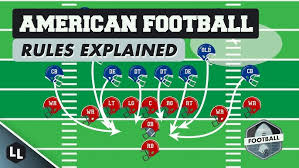American Football Rules
SPORT
8/12/20253 min read


American football is a team sport played with an oval-shaped ball on a rectangular field with goalposts at each end. The objective is to score more points than the opposing team within the allotted time. Here's a breakdown of the fundamental rules:
The Game and How to Play
Teams and Field: Two teams of 11 players each are on the field at a time. The playing field is 100 yards long with a 10-yard "end zone" at each end.
Offense and Defense: The team with the ball is the "offense" and tries to advance it down the field. The team without the ball is the "defense" and tries to stop the offense.
The Goal: The offense's ultimate goal is to move the ball into the opponent's end zone to score a touchdown.
Downs: The offense gets four attempts, called "downs," to advance the ball at least 10 yards.
If they succeed, they earn a "first down," and the count of four downs resets.
If they fail to gain 10 yards in four downs, they lose possession of the ball. On the fourth down, a team will often punt the ball away to the opponent to gain a better field position, or attempt a field goal if they are close enough to the end zone.
How to Score Points
Touchdown (6 points): A touchdown is the most valuable score. It's achieved when a player carries the ball into the opponent's end zone, or catches a pass while in the end zone. The defense can also score a touchdown by intercepting a pass or recovering a fumble and running it back to the opponent's end zone.
Extra Point or Two-Point Conversion (1 or 2 points): After a touchdown, the scoring team gets one more play from a short distance from the goal line.
Extra Point (1 point): The team can kick the ball through the uprights of the goalpost for one point.
Two-Point Conversion (2 points): The team can try to get the ball into the end zone again with a run or a pass play.
Field Goal (3 points): If the offense is close to the opponent's goal line but can't get a touchdown, they can attempt a field goal. The team's kicker kicks the ball through the uprights for three points.
Safety (2 points): A rare scoring play where the defense tackles an offensive player who has the ball in their own end zone. This awards the defense two points.
Common Penalties
A penalty is called when a rule is violated, and an official throws a yellow flag to signal the foul. Penalties result in a loss of yardage for the offending team. Some common penalties include:
False Start: An offensive player illegally moves before the ball is snapped.
Offsides: A defensive player crosses the line of scrimmage before the ball is snapped.
Holding: A player illegally grabs or restrains an opponent who doesn't have the ball.
Pass Interference: A defender makes illegal contact with a receiver to prevent them from catching a pass.
Roughing the Passer: A defensive player makes illegal contact with the quarterback after they have thrown a pass.
Player Positions
Teams are typically divided into three units: offense, defense, and special teams.
Offense: The offense is focused on moving the ball and scoring.
Quarterback (QB): The leader of the offense, who receives the snap and either hands the ball off, throws a pass, or runs with it.
Running Back (RB): A player who primarily runs with the ball but can also catch passes.
Wide Receiver (WR): Players who run downfield to catch passes.
Offensive Line: A group of five players whose main job is to block for the quarterback and the ball carrier.
Defense: The defense tries to stop the offense.
Defensive Line: The players on the line of scrimmage who try to tackle the ball carrier or pressure the quarterback.
Linebackers (LB): Players who line up behind the defensive line and are responsible for tackling, rushing the quarterback, and defending against passes.
Defensive Backs (Cornerbacks and Safeties): Players who cover wide receivers and try to prevent catches.
Special Teams: These players are on the field during kicking plays.
Kicker (K): Kicks field goals, extra points, and kickoffs.
Punter (P): Kicks the ball away to the opponent on fourth down.
